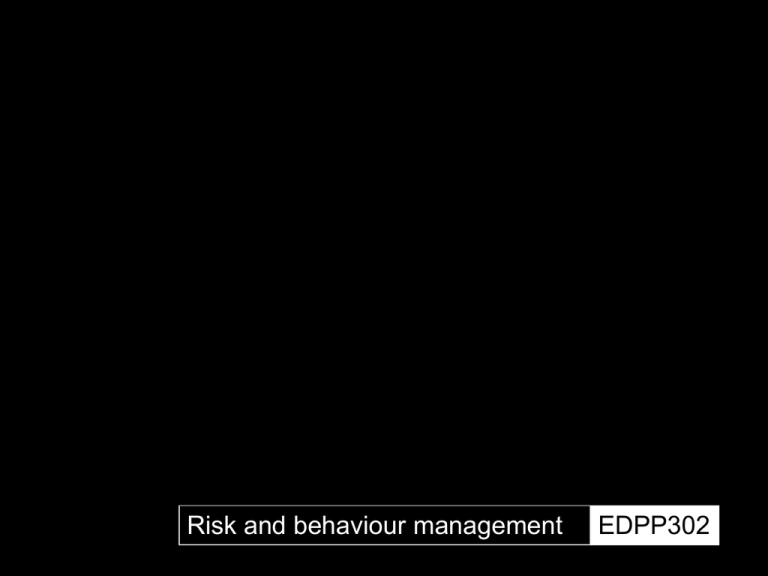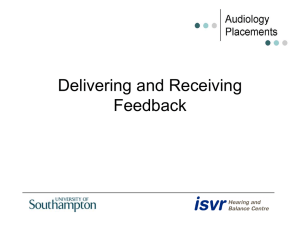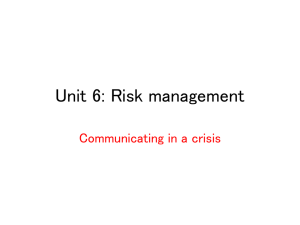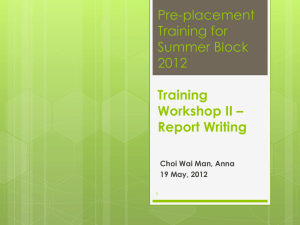
Risk and behaviour management
EDPP302
A framework
for
A framework
classroom for
management
Practical framework for
intervention from CPI
classroom
management
A range of approaches based on theoretical models
Ray’s Teaching tips for dummies
art of teaching
theactivities
quality
skills
that of
(Qld
DET)
teaching
impart
knowledge
(University
Tasmania)
(NSWofDET)
Let’s talk ‘pedagogy’
PEDAGOGY - choosing a palate
TRAINING
PRACTICE
Information
Information
Information
Philosophy
Philosophy
Philosophy
Skills
Skills
Skills
Personality
Personality
Personality
Framework for Teaching
A consistent approach with sound,
well communicated principles,
that allows flexible actions
in response to individual circumstances,
and reflects a ongoing belief
in the inevitability of change
Behaviour
your Management Plan
Step 1 - Develop an understanding of the different
approaches used in behaviour management
Step 2 - Create a personal platform of principles that
reflect your own beliefs, personality and
strengths.
Step 3 - Using the models and your personal platform as
a basis, design a behaviour management plan
that incorporates the prevention, management
and correction of student behaviour.
Step 4 - Test reflect modify
Practical framework for intervention from CPI
Crisis development model 1
The Crisis Development Model
Crisis development/behaviour levels
1.
Anxiety
2.
Defensive
3.
4.
An empathic, nonjudgemental
Acting out approach
person
attempting to alleviate
anxiety
Tension reduction
Staff attitudes/Approaches
Supportive
A noticeable increase or change
in behaviour eg pacing, finger
tapping, staring, wringing hands
CDM - Defensive
The Crisis Development Model
Crisis development/behaviour levels
Staff attitudes/Approaches
1.
Anxiety
Supportive
2.
Defensive
Directive
3.
4.
An approach in which a staff
member takes control of a
potentially escalating
situation by setting limits
The beginning stage of loss of
rationality. At this stage, an
individual often becomes
belligerent & challenges
authority
CDM - Acting out
The Crisis Development Model
Crisis development/behaviour levels
Staff attitudes/Approaches
1.
Anxiety
Supportive
2.
Defensive
Directive
3.
Acting out person
Nonviolent physical
crisis intervention
4.
Safe, non-harmful control and
restraint positions to safely control
an individual until he can regain
control of his behaviour. These
techniques should be utilised as a
last resort, when an individual
presents a danger to self or others.
The total loss of control
which results in a physical
acting-out episode
CDM - Therapport
The Crisis Development Model
Crisis development/behaviour levels
approach used to re1. An Anxiety
establish communication with an
individual who is experiencing
2. Tension
Defensive
Reduction. Builds
relationships with individual after
a crisis.
3.
Acting
out person
4.
Tension reduction
Staff attitudes/Approaches
Supportive
A decrease in physical and
emotional energy that occurs
Directive
after
a person has acted out,
characterised by the
Nonviolent
regaining ofphysical
rationality
crisis intervention
Therapeutic rapport
Reasons for using the Crisis development Model
• helps us to intervene early and appropriately
• helps us to avoid overreacting or underreacting
• helps us to avert a crisis
The crisis model
THE CRISIS CYCLE
Integrated experience
External control
Staff actions
Internal control
Client actions
preventive
corrective
restorative
Prepare - Hudson landing
PREPARE,
Rehearse, PLAN,
Review,PERFORM
Respond
click image for video
A range of approaches based on theoretical models
The Approaches or Models
Fred Jones - Positive Discipline
Body language
Jacob Kounin - Preventative discipline
Incentives
Meeting needs of
Positive
students
relationships
Canter & Canter - Assertive Discipline
Integration of teaching
Creative/divergent
and discipline
B.F. Skinner - Applied Behaviour Analysis
Clear
Democratic
relationships
Focus
thinking
on thinking
rules/consequences
Ripple
Cost
Effect,
of praise
Withitness,
Bill Rogers - Decisive Discipline
Challenging
Mastery learning
beliefs
Understanding
Overlapping,
Effective
goals
of
Positive
Focus
on actions
Transitions,
behaviour
Group
William Glasser - Quality Schools
reinforcement
Positive
Planning
interactions
changes
Focus,
Satiation
Functional
Encouragement
teacher
role rules,
not
Cognitive Behavioural - Ellis, Wragg,Firm
Peterson
4Rs
-rights,
assessment
praise routines
responsibilities,
looking
exceptions
Understanding behaviour - Dreikurs, Balson
Plannedforresponse
Negotiation
Clear
behaviour
plan
Doing
it differently
Haim Ginott, Carl Rogers - Humanist approaches
Scaling
Avoid secondary
behaviours
Strengths Based Intervention - Durrant, Kowalski
Jacob Kounin
Bill Rogers
Decisive Discipline
Group Management
Fred Jones
Neo-Adlerian
Positive Discipline
Balson/Dreikurs
Humanism
Ginott/Rogers
Systems Theory
Solution focussed
Applied Behaviour
Analysis
Choice Theory
Behaviour Modification
William Glasser
Canter & Canter
Assertive Discipline
Cognitive-behaviourism
Models of Behaviour Management Continuum
Autocratic
Democratic
Student
Laissez-faire
empowered
Limit Setting
Leadership
Internal
Non-directive
motivation
CONTINGENCY APPROACH
Developing a toolkit of strategies
Assertive discipline
Decisive Discipline
Canter & Canter
B. Rogers
Teacher
Talk Sense to Yourself
Solution focused
intervention
K. Kowalski
M. Durrant
empowered
J. Wragg
External motivation
Stop, think, do
L. Petersen
student empowered
internal motivation
Process Audit
Matching practice with beliefs. An essential check to
confirm the validity of what we do against the
framework on which it is based.
EXAMPLE:
BELIEF
Students need to be
responsible for their
behaviour
PRACTICE
X
Suspended students
Suspension
of students
required
and
return
to
create
to school
restorative
without
plan
originalreturning
before
issues resolved
to school
Ray’s Teaching tips for dummies
The ‘ FOR DUMMIES’ series of publications
and website resources is the property of
Wiley Publishing, Inc. All rights reserved.
Find out more:
http://au.dummies.com/Section/index.html
Contents
Introduction
9 tips for survival in the classroom
1.
Realistic expectations
2.
A thick skin
3.
The moving target
4.
More than intentions
5.
Button pushing
6.
More poker than pedagogy
7.
Use your instincts
8.
Keep cool
9.
Chunk/funk/dunk
Ray’s Teaching tips for dummies
Introduction
are ne
ed
Quic
kTim
de co e™ an d
a
mpr es
ed to
see th so r
is pict
ure.
You’ve looked at the theories
and seen some of the
approaches recommended.
So what happens now. . .
Here’s a common sense guide
to applying this knowledge for
success with teaching kids in
your classroom.
Ray’s Teaching tips for dummies
9 teaching tips
#1
Realistic expectations
Don't go in with the
expectation that teaching
kids will make you feel good.
Just feel good to be working
with kids.
QuickTime™ and a
decompressor
are needed to see this picture.
Ray’s Teaching tips for dummies
9 teaching tips
#2
A thick skin
You need a thick skin
. . . and some body
armour wouldn't be a
bad idea.
Ray’s Teaching tips for dummies
9 teaching tips
#3
The moving target
Understand you are an
easy target
. . . so move around.
Ray’s Teaching tips for dummies
9 teaching tips
#4
More than intentions
Just being caring,
enthusiastic and young
doesn't mean a thing
. . . on their own.
Ray’s Teaching tips for dummies
9 teaching tips
#5
Button pushing
Kids like to press buttons
. . . and you are most
likely the one with the
biggest bang.
Ray’s Teaching tips for dummies
9 teaching tips
#6
More poker than pedagogy
Managing student learning is
just as much a mix of theatre
and poker as knowledge and
skills
. . . know when to hold them
and know when to fold them.
It’s largely bluff and dare.
Ray’s Teaching tips for dummies
9 teaching tips
#7
Use your instincts
Use your instincts and
intuition
. . . by the time you know
what students are up to it
is already too late.
Ray’s Teaching tips for dummies
9 teaching tips
#8
Keep cool
At all costs keep your cool.
. . . and learn how to find
it when it gets lost..
Ray’s Teaching tips for dummies
9 teaching tips
#9
Chunk/funk/dunk
Work needs to be
. . . clearly presented in
do-able chunks, interesting
and engaging, and leave
students with a sense of
accomplishment.
Ray’s Teaching tips for dummies
Follow these tips and your
teaching will be
. . . fun and relaxing,
challenging and rewarding,
exciting and unpredictable
. . . often with only moments
between each experience.
Ray’s Teaching tips for dummies
the skills
Problem Ownership – the window of blame
Reflective listening
Influential summary
Cognitive restructuring
developing positive self talk
Solution focused dialogue
looking for exceptions and the use of scaling
Negotiation
VERBAL COMMUNICATION
Empathic or Reflective Listening
An active process to discern what a people are really saying.
It can rapidly defuse crisis situations . . .
. . . and provides the foundation for therapeutic rapport
1. Give undivided attention
2. Be non-judgemental
3. Focus on feelings not just the facts
4. Allow silence for reflection
5.
5. Restate/rephrase the message
from NCI training materials: The Crisis Prevention Institute, Chicago 2007
An example of these skills from some
experts in student behaviour
Video available from subject website - week 2
SKILLS Reflective Listening
rationale
Aims to defuse emotions
Provides insight into the beliefs and thinking behind incidents
Allows the teacher to remain detached from the emotions and focused
on the issue
Most relevant in times of stress and conflict
Start with an open question – Tell me what happened?
method
Stay in tune with the emotions not the content being expressed.
When responding use the emotion as the key to your comment eg. “So
you get really annoyed when the teacher calls you out and other people
are talking too?”
It usually takes at least 3 reflections before emotional levels subside.
Do not worry about agreeing or reinforcing the viewpoint of the other
person. Your time will come once emotions are de-escalated.
Remain detached from the person and attuned to the issue at hand.
rationale
SKILLS Influential Summary
Aims to bring the issue around to the point at which a resolution
can be discussed.
Allows the other person to affirm that the issue has been identified.
Provides the starting point for the teaching of behaviour
management skills
method
Takes an understanding of the emotions drawn out from reflective
listening and adds your insight into what is contributing to the
issue/conflict
Involves reading the emotions that have surfaced through the
reflective listening and interpreting these against the basic human
needs and goals of behaviour which underlay our actions
Gets a YES as an affirmation that the issue has been identified
Involves the use of intuition more than intellect
The Tension Model
3
CONSEQUENCES
an outcome of decisions
Positioning
Skill based
subjective
circular flow
individual
FEEDBACK
modelling
narrative
reflection
notices difference
evocative
DECISION MAKING
TENSION
disequilibrium
dissonance
Tension
issue resolved
continues
advice giving
lecturing
interrogation
transparent options
judgemental
prescriptive
References
Konza, D.,
Grainger, J. &
Bradshaw, D.
2001
Classroom management - A
survival guide. Social Science
Press. Australia (Chaps 4 & 5)
Porter, L.
1996
Student Behaviour Theory and practice. Allen &
Unwin. Australia (Part 1)
Powerpoint created by Ray Handley 2010










